Food Away From Home Market Research, 2031
The global food away from home market size was valued at $4.3 trillion in 2021, and is projected to reach $5.9 trillion by 2031, growing at a CAGR of 2.3% from 2022 to 2031.
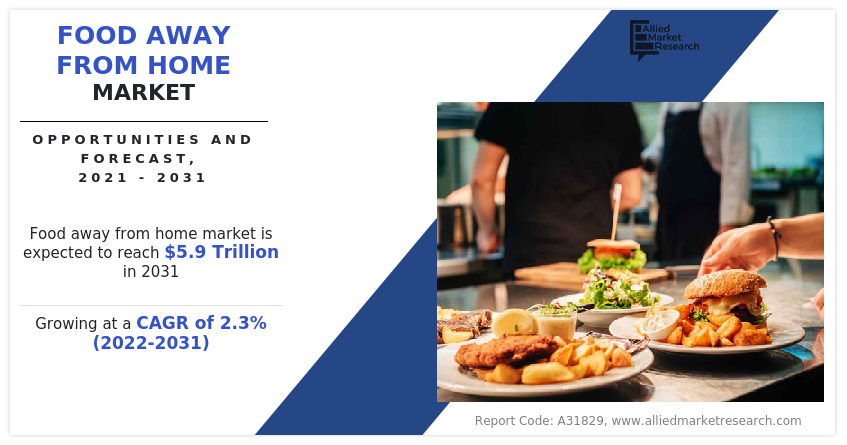
The food away from home market is segmented into Delivery Model, Application, Type of Occasion and Ownership Type.
Food away from home means food prepared or cooked away from home but may be consumed at home or away from home. The global FAFH market is experiencing significant growth in terms of value due to surge in global population, rise in disposable income, increase in popularity of cloud kitchens, rise in penetration of fast-food chains, and changes in food habits of consumers.
Moreover, on account of the surge in the prevalence of fast-food chains in developing nations, the global food away from home market is anticipated to experience considerable expansion during the forecast period. Popular international fast-food companies like Yum Brands, McDonald's, Subway, KFC, and Dunkin' Brands are rapidly expanding their market share in countries like Brazil, India, China, and Indonesia. In the upcoming years, the fast-food restaurants sector is anticipated to gain prevalence due to increase in urbanization of rural areas. The primary causes that are anticipated to increase the demand for fast food include a rise in disposable income of the consumers, surge in women’s employment, busy and hectic lifestyle, and easy and quick availability of the desired type of fast food.
The rapid increase in the female workforce is expected to drive the food away from home market growth owing to the busy schedule of both partners in a family which leads to a reduction in the time for cooking and buying vegetables. According to the report of the U.S. Bureau of Labor Statistics, women’s labor force participation was 57.4% in 2019, up from 57.1% in 2018. According to the report of the NITI (National Institution for Transforming India) Aayog, the share of female labor in the total labor force increased from 23.1 to 27.9% in two years from 2018-2020. Such a rise in the female workforce coupled with rapid urbanization is expected to drive the growth of the FAFH market during the forecast period since more female workforce causes more time-poor consumers which is one of the main reasons for the growing food away from home market demand.
Furthermore, the growing popularity of different cuisines is further boosting the growth of the food away from home market. Globalization and the free flow of information across the globe through the internet have led to increased awareness of international cuisines among the global population. Chinese and Thai food has been a great success globally. Moreover, the globe has witnessed a significant rise in the number of restaurants, cafes, bars, and food trucks across developed and developing nations in the past decade. For instance, in 2019, Subway had approximately 41,600 stores worldwide, similarly, McDonald, Starbucks, KFC, Pizza Hut, Restaurant Brands International, and Dunkin Donut had 37,855, 30,000, 23,000, 18,515, 25,809, and 9,200 worldwide stores, respectively. The major fast-food chains have been investing heavily in business expansion in different regions to reach out to a large number of customers, which has boosted the overall growth of the food away-from-home industry.
The tourism industry has significantly contributed to the food away from home market growth. The rise in number of domestic and international tourists has significantly driven the growth of the hotel industry, thereby fueling the growth of the food away from home market. The surge in consumer expenditure on traveling is expected to foster the demand for food away from home market in the near future.
The proliferation of digital technologies has powered the adoption of digital devices and platforms among food service units and consumers across the globe. The growth in the penetration of numerous online food delivery platforms such as Zomato, Swiggy, Grubhub, Doordash, Foodpanda, and Uber Eats, globally has boosted the growth in the number of ghost kitchens and cloud kitchens. Millennials and Gen Z are the major users of online food delivery platforms owing to the ease and conveniences associated with the home delivery of food. The growth in the penetration of the internet and the rise in the adoption of smartphones among the population have fueled the adoption of online delivery platforms. According to the International Telecommunication Union (ITU), around 4.9 billion, or 63% of the global population had access to the internet in 2021. This represented that the number of internet users across the globe had increased by 17% since 2019. Most internet users access the internet through their smartphones. Therefore, the rapidly rising number of internet users across developed and developing economies is expected to boost the user base of various online food delivery platforms in the near future, which will significantly boost the demand for food away from home market.
According to the food away from home market analysis, the market is segmented on the basis of delivery model, application, type of occasion, ownership type, and region. On the basis of delivery model, the market is segregated into dine in, take away, and home delivery. On the basis of application, it is divided into restaurants, schools and colleges, hotels and motels, retail stores and vending, and others. The restaurants segment is further fragmented into full service restaurants and limited service restaurants. Further, on the basis of type of occasion, the market is categorized into entertainment, travel, retail, and freestanding. On the basis of ownership type, the market is bifurcated into independent and chains. Region-wise, the food away from home market is analyzed across North America, Europe, Asia-Pacific, and LAMEA (Latin America, The Middle East, and Africa).
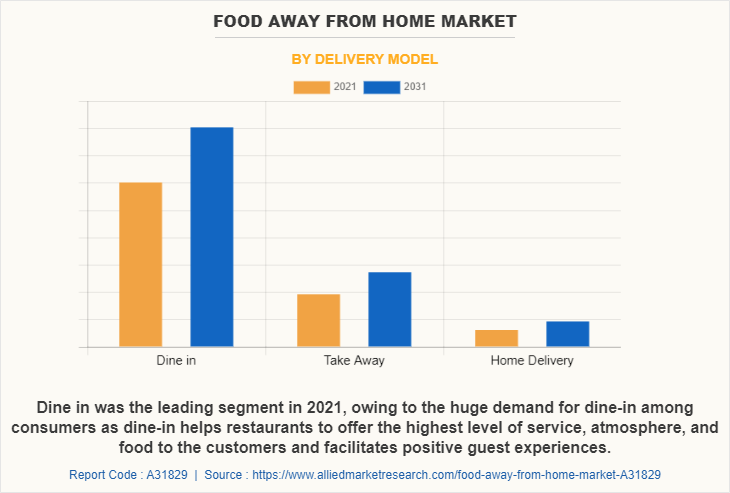
As per the food away from home market forecast, by delivery model, the dine-in segment dominated the market, garnering a market share of 70.4% in 2021. Dine in is the most preferred and traditional delivery model across the globe, which is a major factor behind the dominance of this segment in the market. Dine-in helps restaurants to offer the highest level of service, atmosphere, and food to the customers and facilitates positive guest experiences. The service, food quality, price, location, and ambiance of the restaurants are some of the major traits that influence or attract customers to the dine-in delivery model. On the other hand, home delivery is anticipated to be the fastest-growing segment during the forecast period. The rapidly growing user base of food delivery platforms such as Doordash, Foodpanda, Zomato, and Swiggy is significantly boosting the growth of the home delivery segment in the market. The millennials and Gen Z population across the globe are anticipated to be the key drivers of the home delivery segment.
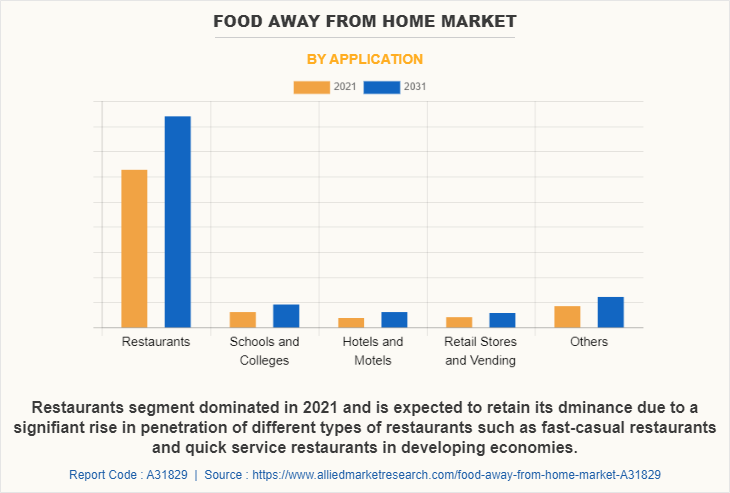
As per the food away from home market trends, by application, the restaurants segment dominated the market in 2021, accounting for 73.5% of food away from home market share. This is significantly attributed to the huge penetration of huge number of full service and limited service restaurants across the globe. The rise in the popularity of the dining-out culture, coupled with the rising participation of women in the workforce has significantly boosted the growth of the restaurant segment in the market. Furthermore, the changing food habits and busy and hectic life schedules of people is further driving the demand for fast food. This is attracting huge investments by the top global fast-food chains to expand their businesses in different regions. The growth in the penetration of popular fast-food chains like KFC, Pizza Hut, and Subway is expected to foster the growth of the restaurants segment in the forthcoming years.
As per food away from home market analysis, hotels and motels is expected to be the fastest-growing segment during the forecast period. This is majorly attributed to the growing number of domestic and international tourist arrivals in the various tourist destinations across the globe. According to the United Nations World Tourism Organization (UNWTO), “International arrivals increased 182% year-on-year in Q1 2022 to an estimated 117 million international arrivals compared to 41 million in Q1 2021. Of the extra 76 million international arrivals, about 47 million were recorded in March.”
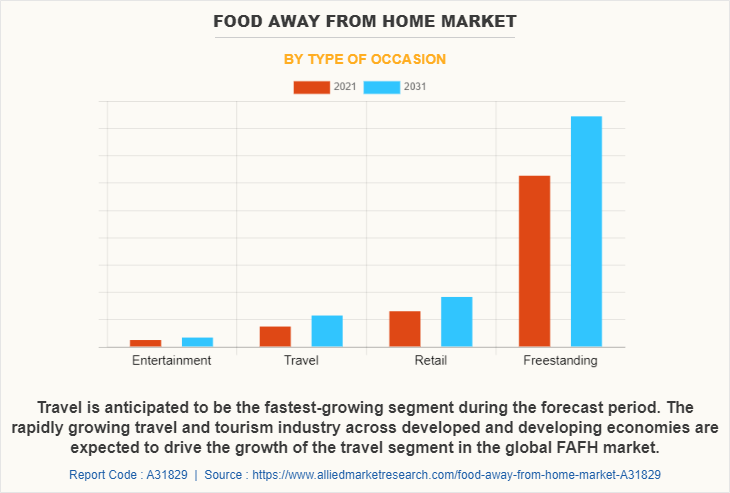
By type of occasion, the market was dominated by the freestanding segment in 2021. This trend has been influenced by a variety of factors, such as a higher proportion of women working outside the home, an increase in two-earner households, higher incomes, more easily accessible and reasonably priced fast-food restaurants, more advertising and promotion by large food service chains, and smaller household sizes. The main drivers anticipated to drive the expansion of the freestanding segment in the near future are the increase in the penetration of fast-food restaurants, the rise in disposable income, the increasing urbanization, and the growing acceptance of online meal delivery apps among the population.
Travel is expected to be the fastest-growing segment during the forecast period. It is anticipated that the constantly expanding travel and tourism sectors in both established and developing nations will propel the expansion of the travel segment in the global FAFH market. A significant element that is projected to fuel the expansion of the FAFH market through the travel segment is the increased government spending on creating infrastructure and enhancing connectivity to encourage tourism. During the projected period, this segment's expansion is anticipated to be aided by the developing economies' increasing urbanization and urban population.
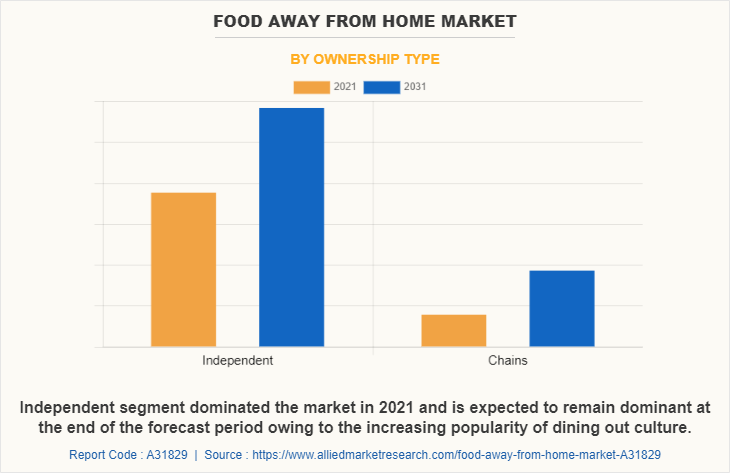
By ownership type, the chains is expected to be the fastest-growing segment during the forecast period. This market is predicted to expand quickly, in part because fast-food chains are becoming more prevalent in developing nations like China, India, Indonesia, and Vietnam. The expansion of well-known restaurant chains in the worldwide market for meals consumed away from home is influenced by the shifting dietary preferences and lifestyles of consumers in developing countries.
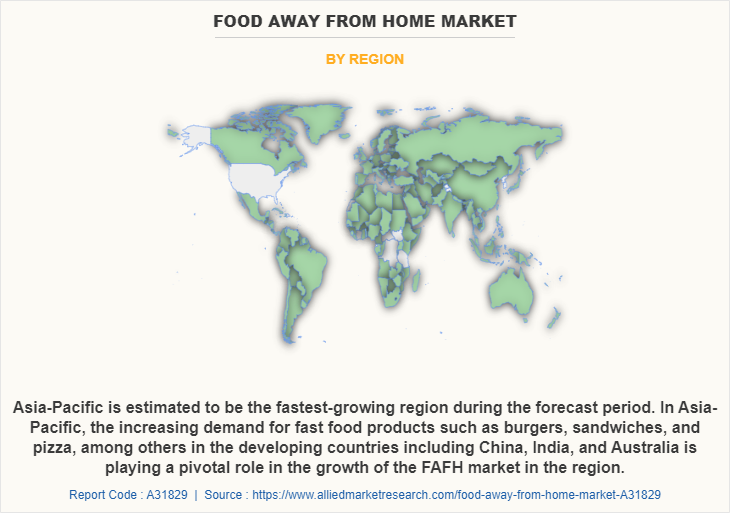
North America was the largest market with 36.4% of the food away from home market share in 2021, while Asia-Pacific is estimated to be the fastest-growing market owing to the rising penetration of popular restaurant chains in the region and the rise in popularity of eating-out culture. Numerous well-known restaurant chains, including Carrabba's Italian Grill, The Cheesecake Factory, Texas Roadhouse, McDonald's, KFC, and Olive Garden, are found throughout the U.S. The proliferation of restaurant chains throughout the nation, together with the enormous popularity of the dining-out lifestyle, high disposable income, and expanding use of online meal delivery services, are all key drivers of the expansion of the North American food away from home market.
A major factor in the expansion of the FAFH market in Asia-Pacific is the rising demand for fast food items like burgers, sandwiches, and pizza among others in developing nations like China, India, and Australia. The region's shifting lifestyle is the main cause of this. Additionally, a number of small and midsize food manufacturing businesses are boosting their investments in developing nations, which is helping the market expand. The high population density, consumer taste & preferences, and the rising number of fast-food restaurants & trucks are the main factors driving the regional fast-food market.
Chipotle Mexican Grill, Sysco Corporation, Yum Brands, Inc., Darden Concepts, Inc., Restaurant Brands International, Inc., Zensho Holdings Co., Ltd., SSP Group Plc, Jubilant FoodWorks Limited, Burger King Corporation, Cloud Kitchens, Bid Corporation, Aramark, SATS Ltd., Compass Group PLC, and Sodexo are the major companies profiled in the food away from home industry report. These manufacturers are constantly engaged in various developmental strategies such as partnerships, mergers, acquisitions, and new product launches to gain a competitive edge and exploit the prevailing food away from home market opportunity.
Key Benefits For Stakeholders
- This report provides a quantitative analysis of the market segments, current trends, estimations, and dynamics of the food away from home market size from 2021 to 2031 to identify the prevailing food away from home market opportunities.
- The market research is offered along with information related to key drivers, restraints, and opportunities.
- Porter's five forces analysis highlights the potency of buyers and suppliers to enable stakeholders make profit-oriented business decisions and strengthen their supplier-buyer network.
- In-depth analysis of the food away from home industry segmentation assists to determine the prevailing market opportunities.
- Major countries in each region are mapped according to their revenue contribution to the global market.
- Market player positioning facilitates benchmarking and provides a clear understanding of the present position of the market players.
- The report includes the analysis of the regional as well as global food away from home market trends, key players, market segments, application areas, and market growth strategies.
Food away from home Market Report Highlights
| Aspects | Details |
| Market Size By 2031 | USD 5.9 trillion |
| Growth Rate | CAGR of 2.3% |
| Forecast period | 2021 - 2031 |
| Report Pages | 385 |
| By Delivery Model |
|
| By Application |
|
| By Type of Occasion |
|
| By Ownership Type |
|
| By Region |
|
| Key Market Players | Zensho Holdings Co., Ltd, Yum Brands, Inc, Sysco Corporation, Bid Corporation, Aramark, Darden Concepts, Inc, Restaurant Brands International Inc, SATS Ltd., Sodexo, SSP Group Plc, Jubilant FoodWorks Limited, Compass Group PLC, Cloud Kitchens, Burger King Corporation, Chipotle Mexican Grill |
Analyst Review
This section provides the opinions of top-level CXOs in the food away from home industry. According to them, the rise in preference for quick-service restaurants over full-service restaurants has been identified as an important driver for the growth of the market. Changes in food habits and the busy lifestyles of consumers have led to an increase in demand for fast food. Rapid changes in the supporting factors such as disposable income, consumer preferences, increase in the working women population, and digitization has resulted in a rise in the number of quick-service, pop & shop, and other product types of restaurants. This in turn drives the growth of the food away from home market. Factors such as growth of the hospitality industry and increase in tourism support the growth of the market. Asia-Pacific and Europe are offering incremental growth opportunities for fast food, and hence the market in the region is anticipated to grow at the highest CAGR. Health concerns among consumers are one of the major limitations for the global food away from home market. Moreover, the introduction of fast-casual food is expected to restrain the growth of the market. Numerous players are stepping into the fast-food market with healthy meals. Increase in fast food restaurants and changes in consumer taste and preference are expected to drive the market in the forthcoming years.
The global food away from home (FAFH) market size was valued at $4,266.3 billion in 2021 and is estimated to reach $5,848.7 billion by 2031, growing at a CAGR of 2.3% from 2022 to 2031. On account of the surge in the prevalence of fast-food chains in developing nations, the global food away from home (FAFH) market is anticipated to experience considerable expansion during the forecast period.
The food away from home (FAFH) market report is available on request on the website of Allied Market Research.
The forecast period considered in the global food away from home (FAFH) market report is from 2022 to 2031. The report analyzes the market sizes from 2022 to 2031 along with the upcoming market trends and opportunities. The report also covers the key strategies adopted by the key players operating in the market.
Chipotle Mexican Grill, Sysco Corporation, Yum Brands, Inc., Darden Concepts, Inc., Restaurant Brands International, Inc., Zensho Holdings Co., Ltd., SSP Group Plc, Jubilant FoodWorks Limited, Burger King Corporation, Cloud Kitchens, Bid Corporation, Aramark, SATS Ltd., Compass Group PLC, and Sodexo are the major companies profiled in the food away from home (FAFH) market report.
According to the food away from home market analysis, the market is segmented on the basis of delivery model, application, type of occasion, ownership type, and region. On the basis of delivery model, the market is segregated into dine in, take away, and home delivery. On the basis of application, it is divided into restaurants, schools and colleges, hotels and motels, retail stores and vending, and others. The restaurants segment is further fragmented into full service restaurants and limited service restaurants. Further, on the basis of type of occasion, the market is categorized into entertainment, travel, retail, and freestanding. On the basis of ownership type, the market is bifurcated into independent and chains. Region-wise, the food away from home market is analyzed across North America, Europe, Asia-Pacific, and LAMEA (Latin America, The Middle East, and Africa).
A major factor in the expansion of the FAFH market in Asia-Pacific is the rising demand for fast food items like burgers, sandwiches, and pizza among others in developing nations like China, India, and Australia. The region's shifting lifestyle is the main cause of this. Additionally, a number of small and midsize food manufacturing businesses are boosting their investments in developing nations, which is helping the market expand.
North America was the largest market with 36.4% of the market share in 2021, while Asia-Pacific is estimated to be the fastest-growing market owing to the rising penetration of popular restaurant chains in the region and the rise in popularity of eating-out culture. Numerous well-known restaurant chains, including Carrabba's Italian Grill, The Cheesecake Factory, Texas Roadhouse, McDonald's, KFC, and Olive Garden, are found throughout the U.S.
The food away from home industry was one of the worst impacted sectors due to the outbreak of the COVID-19 pandemic. The rapid spread of the disease among the global population has forced governments to impose strict lockdown measures to curb the spread of the COVID-19 disease. This prolonged lockdown across the globe led to the closure of most restaurants, bars, schools, colleges, and other commercial food service units. The dine-in I restaurants completely vanished during the pandemic. The commercial food service units witnessed a significant decline in sales in 2020.
Loading Table Of Content...


